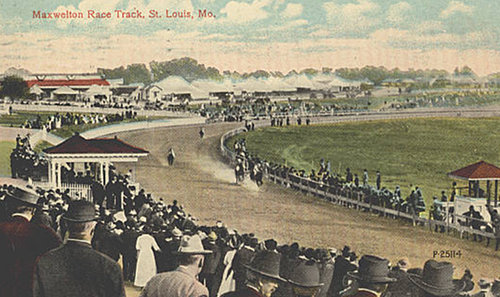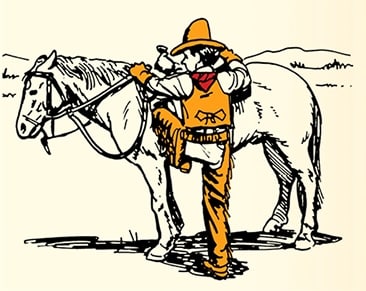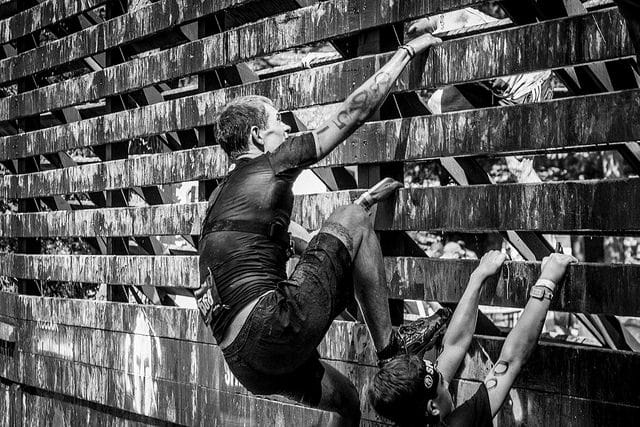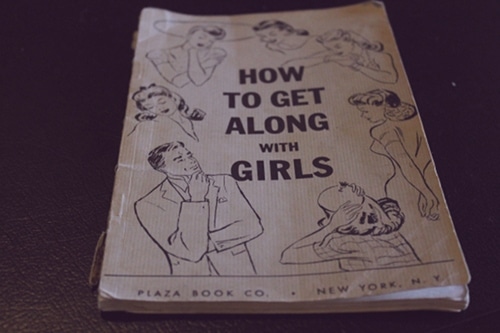
Growing up, I never visited a horse track or saw a single horse race.
That all changed when I met Kate and married into a horse race-loving family. Rick Surwilo, my father-in-law, had started going to the racetrack as a teenager with his family. This was a time before lotteries and casinos, and horse racing was the only legal form of gambling, so it was something really different to go and do. His family lived in Connecticut but had bought a little home in Woodford, Vermont, and Rick’s dad loved to take the wife and kids to the Green Mountain Race Track in Pownal, just a little ways south of there. They’d set up their lawn chairs by the finish line, and Grandpa Surwilo would take everyone’s orders and go relay the bets to the tellers.

The Green Mountain Race Track in Pownal, Vermont
When I started dating Kate, one of our first, and most romantic, dates was when she took me to the racetrack here in Tulsa. We had a great time betting on a few horse races while snuggling in the bleachers as a thunderstorm rolled in.
After Kate and I got hitched, her parents would take us to the horse races every other summer or so, and even gave us poor newlyweds a little scratch to bet with. Rick’s father had long since passed away, but Gram Surwilo–every inch the stereotypical feisty Italian grandma–still loved to go and bet on the ponies, just as she had in the old days in Vermont.
I really enjoyed these outings with my extended family, and placing a few bets myself, but I admittedly had no idea what I was doing. I mostly just picked the horses with the names I liked best.
So I jumped at the chance America’s Best Racing offered me a couple of months ago to come see the Spiral Stakes at Turfway Park in Florence, Kentucky, and get some lessons on how to bet on the ponies. Kate and I had a great time there and learned a ton. Betting on horses is a lot more complicated than I had imagined, but it’s really a great deal of fun.
Today, I’ll share some of the basics of what I learned, so that the horse racing neophyte can take advantage of this wonderful spring weather and go down to their local racetrack (or the Kentucky Derby!) feeling like they know what they’re doing.
Why Go to a Horse Race?

The finish line at Turfway Park.
Before we get into the art of betting, let’s talk about why you’d want to visit a horse racetrack anyway. Perhaps you’re thinking, “That’s something my grandpa liked to do, but I’m not interested.”
Watching horse racing at the higher levels of the sport is a wonderful experience. I’m really not much for any other forms of gambling, and personally don’t see the fun in losing my shorts in some dark, smoky casino. But horse racing I like; it feels like entertainment, an experience, an outing. I like that I’m outside. I like that there’s a lot of history and tradition behind it. All in all, whether I win or lose money, I still have a great time.
These days if you want to take the family to a pro basketball or football game, the tickets and food can easily run you $400. Admission to a racetrack is often free, the minimum bet on each horse race is just $2, and you can sometimes bring your own food and drinks. You get to spend all afternoon and evening outside, watching beautiful animals perform at their peak ability. And all this can run you less than a trip to the movies.
And if you’re looking for an affordable, unique date, where you won’t run out of things to talk about, look no further!
Types of Horse Racing Bets

My favorite track I’ve visited: the Saratoga Race Course in NY. Lots of history there–built in 1863, it’s the oldest organized sporting venue of any kind in the United States.
You have two categories of wagers to choose from when you bet on the ponies: straight wagers and exotic wagers. For a beginner, I recommend sticking with straight wagers. They’re simple and cheap. You simply pick one horse to come in first, second, or third. The minimum bet at most tracks for a straight wager is just $2.
Exotic wagers allow you to make multiple bets on multiple horses in a single wager. Exotic wagers are generally much more difficult to win than straight wagers, require an advanced degree of skill and knowledge in horse picking, and are more expensive. However, the payoffs on exotic wagers are much greater than straight ones.
Straight Wagers
Remember with a straight wager, you only bet on one horse.
- WIN– You’re betting that your horse will come in first place. If your horse finishes in first, you get to collect.
- PLACE– When you bet on your horse to “place,” you’re betting that he will come in first OR second. If your horse finishes in first or second, you get to collect. Payout for a place bet is less than a win wager, but you do have the security of being able to cash in if your horse finishes in the top two spots.
- SHOW– You’re betting that your horse will come in first, second, OR third. Since you’re hedging your bets, you have a higher chance of winning, but the payout for a show bet is substantially less than a win or place wager.
- ACROSS THE BOARD– When you bet across the board, you’re betting your horse to win, place, AND show. An across-the-board bet is what’s called a “combo straight wager” because it’s three different bets (win, place, AND show) in one. Because it’s three bets in one, an across-the-board bet is more expensive than a simple win/place/show wager. For example, a $2 across-the-board wager will cost you $6, because you’re making three $2 bets. If your horse comes in first, you get the win, place, and show money. If your horse finishes second, you get place and show money. If your horse comes in third, you just get the show money. Across-the-board bets aren’t usually a good wager because they’re expensive and have less profit potential.
- WIN/PLACE, PLACE/SHOW– Similar to an across-the-board bet in that you’re making multiple straight wagers in a single bet. In a win/place bet, you’re betting your horse to win AND place. If he wins, you collect both the win and place money. If he finishes second, you collect just the place money. In a place/show bet, you’re betting that your horse will place and show. If your horse finishes second, you collect the place and show money; if he finishes third, you just get the show money. Because you’re placing multiple wagers on your horse in a single bet, a win/place and place/show is more expensive. A $2 win/place bet will cost you $4 because you’re betting $2 that your horse wins and $2 that your horse places.
Exotic Wagers
Exotic wagers allow you to bet on multiple horses in a single bet, allowing you to increase your profit potential. But as I mentioned above, they’re much harder to win than straight bets, can get expensive if you’re not careful, and require much more skill in handicapping horses. Feel free to experiment with some exotic wagers after you’ve done a few straight bets.
- EXACTA– You’re betting on two horses to come in first and second in an exact order. For example, if you placed a $2 exacta on horses 3 and 5, you can only collect if horse #3 comes in first and horse #5 comes in second. Exacta bets are popular among skilled horse handicappers because the payoff can be very lucrative. You can also “box” your exacta bet which means your two horses can come in any order in the top two spots and you still win. Boxing an exacta costs twice as much as a straight exacta bet. So a $2 box exacta on horses 3 and 5 will cost you $4.
- QUINELLA– With a quinella bet, you’re betting on two horses to come in first and second in any order. As long as your two horses finish in the top two spots, you win. So if you placed a $2 quinella bet on horses 1 and 6, you can collect if horse #1 and horse #6 come in first and second in any order. You might be thinking, “What’s the difference between a quinella and a box exacta? Both let you win if your two horses come in first or second.” The big difference is cost: a $2 quinella bet costs $2 while a $2 box exacta bet will cost you $4. Why would someone pay more for a box exacta if it’s essentially the same bet as a quinella? The payout for a box exacta is generally more than a quinella bet, that’s why.
- TRIFECTA– You bet that three horses will finish in first, second, and third in an exact order. If you place a $2 trifecta bet on 1-5-7, you can only collect if horse #1 comes in first, horse #5 comes in second, and horse #7 comes in third. You can also box your trifecta bet so you can win if your three horses come in first, second, and third in any order. Boxing a trifecta will significantly increase the cost of your bet because there are many combinations. So a $2 box trifecta bet will actually cost you $12 or a $1 trifecta boxed will cost you $6.
- SUPERFECTA– You bet that four horses will finish, first, second, third, and fourth in an exact order. As with exactas and trifectas, you can box a superfecta at an additional cost. The minimum bet is often 10-cents, which makes it more appealing to many people.
I’m not going to get into “keying” horses with these exotic bets. That’s a little bit too advanced for our purposes here. Basically, keying horses allows you to minimize your wager, while increasing your payout if you pick your horses right. It’s something that I’d look into once you get comfortable handicapping horses with exotic wagers.
What to Say to the Teller When You Place Your Bet

Human tellers are fast, accurate, and friendly.
Alright, so you know what kind of bet you’re going to make. Now it’s time to place your bet.
If you’re at the racetrack in person, I recommend only using human tellers. The automatic tellers have big lines, and you risk being shut out of a race because some yokel is making multiple wagers and doesn’t know how to operate the computer. There’s also the risk that you’ll mess up your bet because you punched the wrong button. The human tellers are fast, accurate, and friendly.
Have your money ready in your hand. Things move fast at the counter, especially a few minutes before post. You don’t want to be the guy holding up the line because he’s fumbling through his wallet looking for his $2.
Once you get up to the counter, what do you say to the teller so you don’t sound like an idiot and hold up the line? Here’s your script:
Tell the teller the following in this order:
- Racetrack and race number (only if you’re betting on a race at a different racetrack than the one you’re at)
- Amount of your bet
- Type of bet you’re placing
- Horse’s program number
For example: “Churchill Downs, race seven, $2 to win on #4.”
If you want to do a quinella bet, tell them: “$2 quinella on 3 and 5.”
Now hand the teller your money and take your ticket. Keep it in a safe place. You’ll need it to claim your money if you win. You can tuck it in the front pocket of your shirt, or if you’re wearing a hat, stick it inside your hat band.
How to Pick Your Winning Horse

So now you know how to place a bet at the horse races. With that bit of info, you can go to any track in America and have a good time picking a random horse and betting your $2 on each race. But if you’re like most people, your goal isn’t to simply pay $2 to watch a bunch of horses run around a track. You actually want to win some money! That’s what makes horse racing “the most exciting two minutes in sports.” The suspense and thrill of knowing that each race can make you a bit richer is overwhelming. You can’t help yourself from jumping up, pumping your fist, and yelling “GO, BABY, GO!” as your horse turns the last corner on the track and makes a break for the lead.
But how do you pick a winning horse? There are literally hundreds of books and thousands of websites on handicapping (that means picking) horses and everyone seems to have a different opinion on what factors are the most important to analyze when choosing a horse. While plain old luck is the biggest factor in whether you make or lose money (especially for beginning pickers), handicapping makes the races more fun because it gives you a sense of control, as well as something to chew over between each race.
For the purposes of this post, I’m going to keep the handicapping tips very, very basic. The goal is to give the first time race spectator enough information that he can go to a racetrack and not feel like he’s just randomly picking horses to win. I’d love for all you horse racing junkies to chime in with your tips for our beginner horseplayers.
Get familiar with reading the race day program. Your ability to successfully handicap horses will depend upon your ability to read the race day program. The program is crammed with information that you can use to make smarter bets. In it you’ll find a section for each race that day with the statistics and history on all the horses racing in a particular race. The lines of numbers and lingo in a program can be a bit intimidating at first, but with a little practice you’ll be reading like a (semi) pro in no time.
I could devote an entire article to explaining how to read a race day program, but I won’t. Equibase, the company that creates all the race day programs for every track in the U.S., has a great interactive guide on how to read their race day programs. If you’ve never been to the horse races before, play around with it before you go.
Look at what class levels the horse has been racing at. There are different levels of competition, or classes, in horse racing. As you go up in class, you’ll find better performing horses and higher purses. There are four race classes: maiden races, claiming races, allowance races, and stakes races. Racetracks try to have races with horses at the same level of competition. Horses move up and down classes throughout the year depending on their performance and oftentimes a change in class can affect whether a horse will win or lose.
For example, let’s say the race you’re betting on is a $40,000 allowance race. You have your eye on a horse, so you check its past performance in the program. It looks like he’s been consistently coming in first and second, but you notice that his previous races have all been claiming races. While it’s great that this horse has been bumped up a class, in this particular race he might be outclassed by the other horses who have experience in performing in allowance races. So it might not be a good idea to bet on this horse to win in this particular race.
Past performance on surface type. Racetracks have different surfaces that the horses run on. Some have natural dirt and grass tracks while others have artificial “all-weather” tracks. Horses perform differently on each type of surface. Some horses love dirt tracks, but don’t like the feel of artificial tracks and vice versa. The program tells you each horse’s past performance on the different surface types. If a horse has performed well only on dirt and the track you’re at is an all-weather course, you might consider eliminating her from your list of possible picks.
History with jockey. I like to look at a jockey’s performance history in the program. If a jockey consistently places in first, second, or third no matter what horse he or she is riding, it’s a good indicator of talent. So if I see a good jockey riding a horse for the first time that has consistently finished in the middle of the pack, I might place a bet on that horse, reasoning that with the jockey’s added skill this middle of the pack horse has a good chance of finishing in the top two spots.
I also check to see the history of a jockey with a particular horse. If I see that a horse and jockey have consistently finished in the top three spots together, there’s a good chance they’ll finish in the top three spots in the race that I’m betting on.
Consider the odds. For every race, each horse will have the odds of it winning next to its name in the program. The favorite to win is the horse with the lowest odds. While past performance doesn’t guarantee future results, the statistics show that over time going for the race favorite pays off. If you:
- Bet the race favorite to win, he pays off 33% of the time.
- Bet the race favorite to place (comes in 1st or 2nd), the favorite pays off 53% of the time.
- Bet the race favorite to show (comes in 1st, 2nd, or 3rd), the favorite pays off 67% of the time.
So if you’re looking for an easy way to handicap horses that gives you a good chance of a small return on your money, just bet the race favorite to show.

This horse was really antsy in the paddock. Didn’t put my money on him.
Watch the horse in the paddock. This is my favorite way to handicap a horse. Before every race, the horses are paraded around in an area of the track called the paddock. It gives you a chance to see how the horse looks and is behaving before the race starts. Once I’ve winnowed my list of picks to two or three horses using the info in the program, I like to go over to the paddock to take a gander at how the horses look. Just like you and me, horses have good and bad days. Sometimes when you wake up in the morning you’re raring to go and other times you come down with a case of the Mondays. Same with horses.
Watch the horses to see how they’re behaving. Do they look peppy and eager to race? Mopey and Eeyore-like? Check to see if a horse is sweating a lot. You can tell he’s sweating because he’ll have big dark splotches on his coat. If he’s sweating a lot, it likely means the horse is nervous. Sweat spots by the kidneys indicate that the horse isn’t feeling good, so you might want to pass on him. Some horses will act very jittery in the paddock–turning in circles, biting, rearing. While it’s a sign that the horse has some spunk, he’s wasting all his energy in the paddock instead of saving it for the race. Go with the alert, but calm horse.
Looking for these signs with the horses isn’t very scientific, but it is a lot of fun.
Random, superstitious factors. Of course, you can simply use some random superstitious factor to handicap your horse. You can pick the horse that’s wearing your lucky number or your favorite color. Or you can pick the horse because you like the name. A lot of racegoers have their own silly handicap factors they use. Come up with your own.
Last Minute Tips
You don’t have to bet on every race. For the beginner, the temptation is to bet on every single race in the program. While there is definitely one horse that will win each race, the astute horseplayer culls the entire program for the best bets and might, conceivably, only bet two or three races out of the entire card (card is the term for all the races that day).
Set a budget and bring cash in that amount. If you think you might get carried away with your betting, simply bring a set amount of cash. Once it’s done, you’re done.
Wear a hat. There are few venues these days where a hat doesn’t look out of place. The racetrack is one of them.







